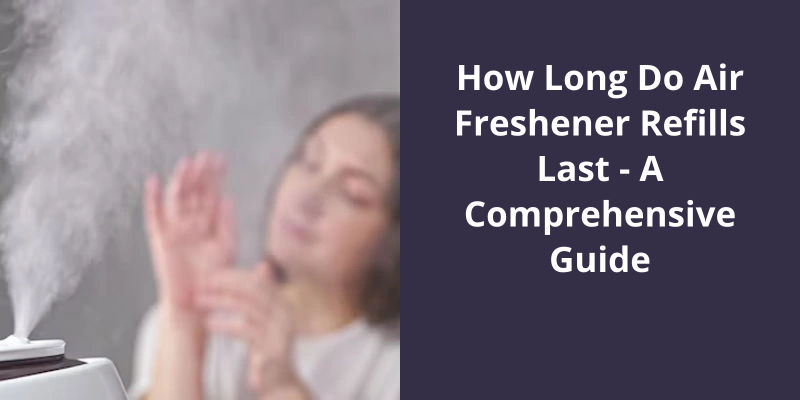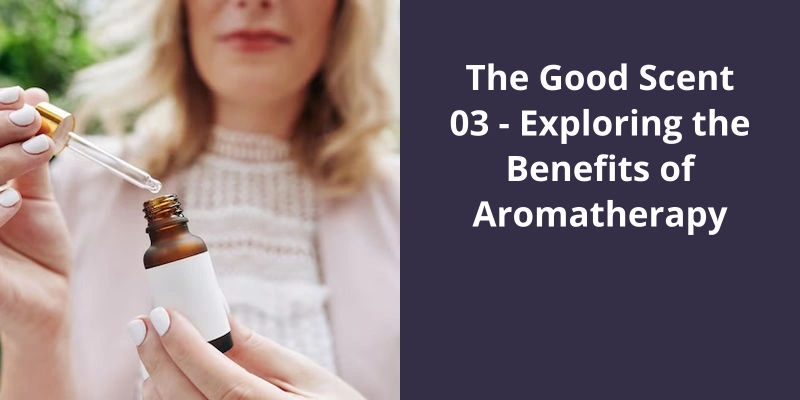Air Freshener refills usually last between 30 to 60 days, depending on their usage. The longevity mainly depends on how often the air freshener is used, its specific kind, and the settings of the device. Some air fresheners come with adjustable settings allowing the user to manage the intensity and frequency of the fragrance released, thus determining its lifespan. For instance, if set at high frequency, the refill may get used up quicker. In general, Regular plug-in air fresheners typically last around 30 days, while those designed for larger rooms can last up to 60 days.

How Long Does an Air Freshener Last?
However, the lifespan of an air freshener heavily depends on several factors, including the size of the room, the strength of the fragrance, the frequency of use, and the quality of the product. For example, if you live in a tiny apartment, you might not need to replace your air freshener as often as someone who lives in a spacious house or runs a busy office. Similarly, if you use a highly concentrated air freshener, it might last longer than a weaker version of the same product.
Additionally, many air fresheners come with a variety of settings that allow you to control how often the fragrance is released into the air. Some can be set to release a burst of scent every few minutes, while others work continuously. Naturally, the more the air freshener is used, the faster it will run out.
For instance, a plug-in air freshener will typically last longer than a spray can as the fragrance is continuously released, instead of being used up all at once. Similarly, a reed diffuser will last much longer than a candle as the oils evaporate slowly over time.
How to Make Your Air Freshener Last Longer
- Place your air freshener in a well-ventilated area.
- Avoid placing it near heat sources, such as radiators or stoves.
- Store it in a cool, dry place.
- Avoid spraying too much at once.
- Replace the cap tightly after each use.
- Try placing a fan near the air freshener to help circulate the scent.
- Consider purchasing a scent booster or refresher spray to enhance the fragrance.
- Use a fabric refresher spray on upholstery or curtains to help the scent last longer in the room.
- Clean your home regularly to eliminate any unpleasant odors that may overpower the scent of the air freshener.
It’s always important to keep in mind that even our favorite air fresheners have a limited shelf life. And while we may not typically think of them as expiring products, it turns out that they can indeed go bad over time. The natural process of oxidization can cause fragrance molecules to evaporate and degrade, leaving us with a less effective product. But just how long can we expect our air fresheners to last before they expire? Let’s take a closer look.
Does Febreze Air Freshener Go Bad?
This is why people often resort to throwing away vaguely smelling bottles of old air freshener in their homes – the scent is just not as strong as it used to be. However, Febreze claims that their air fresheners don’t have an expiration date. According to the company, the product should be effective and safe to use as long as it still has a noticeable scent.
This can happen due to factors such as exposure to extreme temperatures or direct sunlight, causing the fragrance molecules to degrade and evaporate faster than usual.
Luckily, there are a few ways to extend the life of your Febreze air freshener. It’s recommended to store it in a cool, dry place, away from sunlight and direct heat sources such as radiators or heaters. This will help slow down the oxidization process, keeping the scent fresher for longer.
Another tip is to give the bottle a good shake before each use. This helps to redistribute the fragrance molecules, ensuring that the scent is evenly spread through the air. This can also help to revive the scent if it’s become weaker over time.
By taking proper care of your air freshener, you can extend it’s lifespan and ensure that your home smells fresh and clean all year round.
How to Properly Dispose of Old Air Fresheners
- Check the label for disposal instructions
- If the label doesn’t have instructions, contact your local waste disposal facility
- Don’t throw air fresheners in the trash or recycling bin
- Consider using natural air fresheners or essential oils instead
- Reuse or recycle the container if possible
- Dispose of old air fresheners safely to protect the environment
Now that we know how long different types of scented oil refills can last, let’s dive deeper into the factors that affect the duration of scent fill and how you can make the most out of your scented oil warmer.
How Long Does Scent Fill Last?
However, when the warmer is set to high fragrance control, the scent can last for as little as 18 days. This is because higher heat settings cause the oils to evaporate at a higher rate. It’s important to note that factors such as room size, airflow, and temperature can affect the longevity of scented oil refills.
Additionally, the type of scent can also impact how long it lasts. For example, strong, bold scents such as cinnamon or peppermint tend to last longer than lighter, more delicate scents such as lavender or vanilla. This is because the stronger scents have a more intense fragrance and are able to fill the room more quickly.
Higher quality oils tend to last longer because they’re made with better ingredients. Cheaper, lower quality oils may have a shorter lifespan and may not emit as strong of a fragrance as more expensive options.
To extend the life of your scented oil refill, it’s important to regularly clean your warmer and replace the wick. This will help ensure that the oils are able to properly diffuse into the air and will prevent any buildup of residue that could affect the quality and lifespan of the scent.
Now that we know how long a Febreze refill can last, it’s worth exploring the benefits of using this air freshener in your home. Whether you’re combatting stubborn odors or simply looking to create a more inviting atmosphere, Febreze can help you achieve the fresh-tensity you crave. So let’s dive into the reasons why Febreze refills are a must-have for any clean home.
How Long Do Febreze Refills Last?
Febreze has become one of the most popular air fresheners on the market today. It’s known for it’s ability to eliminate unpleasant odors in a room and leave behind a fresh, clean scent. The Febreze Plug-In refill is a convenient way to keep your home smelling great without having to constantly replace the air freshener. But how long do these refills actually last?
According to Febreze, the Plug-In refills can last up to 60 days. However, this can vary depending on a number of factors, including the size of the room, the level of odor, and the intensity setting of the device. If you’ve a large room with a lot of odor, you may need to replace the refill more frequently. On the other hand, if your room is smaller and doesn’t have a lot of odor, the refill may last longer than 60 days.
One way to make your Febreze Plug-In refill last longer is to use it on a lower intensity setting. The device has a dial that allows you to adjust the intensity of the scent, which can help to conserve the refill. Additionally, it’s a good idea to turn off the device when youre not in the room to help prolong the life of the refill.
If youre using your Febreze Plug-In refill every day, you may want to consider buying refills in bulk to save money. However, keep in mind that the refills do have an expiration date, so only buy what you think youll use within a reasonable amount of time.
While plug-in air fresheners may seem like a convenient way to freshen up your home, the hidden costs may surprise you. From the amount of electricity they use to the frequent refill purchases, it’s important to weigh the pros and cons before investing in these devices.
Do Plug-in Air Fresheners Use a Lot of Electricity?
While 4 watts may not seem like a lot, it can add up over time. Especially when you consider the fact that many people use these air fresheners in multiple rooms of their home. In fact, according to some estimates, the average household might spend as much as $60 per year on plug-in air fresheners alone. Thats not an insignificant amount of money, especially in todays economic climate where many people are struggling to make ends meet.
One other thing to consider is the environmental impact of plug-in air fresheners. While they may be convenient and certainly can make your home smell nice, they’re also contributing to the amount of electricity we use as a society. This can have a negative impact on the environment, as the more energy we use, the more carbon emissions are produced. And of course, there’s also the issue of the waste generated by the disposable refill cartridges.
All that being said, there are some steps you can take to reduce the energy consumption of your plug-in air fresheners. For example, you could use them only in rooms where you spend a lot of time, rather than throughout your entire house. You could also use them only for short periods of time, rather than leaving them on all day and night. Finally, you could consider switching to a more eco-friendly option, such as an essential oil diffuser or natural air fresheners like potpourri or candles.
Plug-in air fresheners do use electricity, and may contribute to energy consumption and environmental issues. However, by taking some simple steps to reduce your usage or switching to more sustainable options, you can help minimize the impact and still enjoy a fresh, clean-smelling home. Ultimately, it’s all about finding the balance between convenience, comfort, and responsible energy use.
While air fresheners can leave your home smelling great, there are some potential risks associated with prolonged and excessive use. In some cases, inhaling these sprays too closely or for extended periods of time can lead to serious health problems. It’s important to understand the risks and take appropriate precautions to keep yourself safe.
Is It Bad to Breathe in Too Much Air Freshener?
However, it’s important to note that inhaling too much air freshener can have negative consequences for our respiratory system. The chemicals within them aren’t meant to be ingested or inhaled at such high concentrations, and can cause harm to our lungs. Studies have shown that frequent use of air fresheners is linked to increased incidence of respiratory problems, such as asthma and bronchitis. This is especially true for those with preexisting respiratory conditions.
Additionally, some air fresheners contain volatile organic compounds (VOCs) which can cause eye, nose, and throat irritation, headaches, dizziness, and nausea. These compounds can also contribute to the formation of ozone, which can be harmful to breathe. It’s important to read labels and choose air fresheners that don’t contain VOCs or other harmful chemicals.
There are also potential environmental impacts that result from air freshener usage. Once sprayed into the air, these compounds can settle on surfaces and contribute to indoor air pollution. They can also seep into groundwater and impact aquatic life. In a world where we’re increasingly conscious of our carbon footprint, it’s important to consider the environmental impact of our actions.
It’s best to use air fresheners in moderation and according to directions. Avoid spraying them at close range and opt for products that contain fewer harmful chemicals. Be aware of possible respiratory irritation and discontinue use if symptoms occur. It’s important to strike a balance between clean air and our health, and the health of our environment.
Conclusion
In today's world, where the need for a fresh and clean environment is of utmost importance, air fresheners play a significant role. It’s fascinating to observe how innovative technologies have transformed the way air fresheners function. Though the lifespan may vary depending on usage, this duration is a significant improvement from previously available options.





